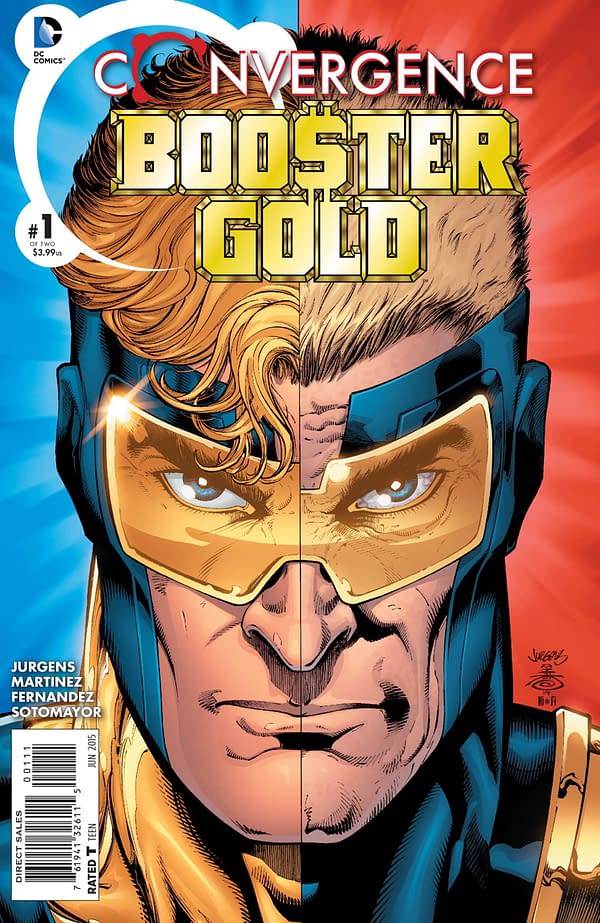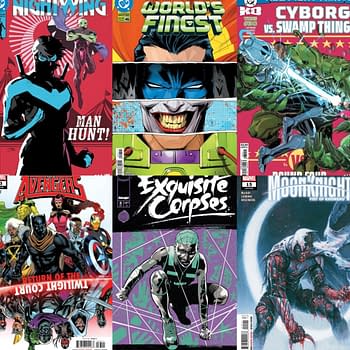Posted in: Comics, Recent Updates | Tagged: blue beetle, booster gold, Comics, convergence, dc comics, detective comics, entertainment, fantastic four, Marvel Comics, world's finest
Thor's Comic Review Column – Fantastic Four #645, Thomas Alsop Vol. 1, Multiversity #2, Convergence #4, Convergence: Booster Gold, Blue Beetle, Shazam, Infinity Inc., World's Finest, Detective Comics
This Week's Reviews:
Fantastic Four #645
Thomas Alsop Vol. 1
Convergence #4
Convergence: Booster Gold #1
Convergence: Blue Beetle #1
Convergence: Shazam! #1
Convergence: Infinity Inc. #1
Convergence: World's Finest
Convergence: Detective Comics #1
The Multiversity #2
Fantastic Four #645 (Marvel, $5.99)
By Jeb D.

And I've been put rather in mind of that comic over these past few months as the current volume of the Fantastic Four series winds down: the storyline's familiar, the character beats well-worn, so its greatest virtue has been in showing us the FF interacting one "last" time with the metastasizing cast of characters in the Marvel U. This time only some of the guest stars are fakes, meeting up with their real counterparts, though, so for those looking for some Cap-on-Cap or Wanda-on-Wanda action, this one's for you.
All of this is taking place at the behest of arguably the blandest villain the team has ever faced—though one who's busily retconning the team's history for no better reason than to make himself seem even slightly interesting (he also blatantly cops bits from Watchmen and other superior comics, but perhaps writer James Robinson thinks of it as "homage"). Leonard Kirk handles the monster-rally aspect of the artwork just fine (it's nice to see him get in a couple of panels of the Agents of Atlas again), and if, as was the case with FF #100, you'll find pleasure in seeing the vast panoply of Marvel characters flying, punching, and power-bolting each other, dig in. But in terms of storytelling, it's more bland than watching the FF against Kirby's bunch of android baddies. In the decades since FF #100, Marvel comics featuring mad jumbles of characters are already pretty thick on the ground, and with all due respect to Robinson and Kirk, I don't see this comic being remembered as fondly: this is just the last issue by the current team of record, not the beginning of the end of a creative partnership for the ages.
The 60-page issue also includes four short stories of the individual team members, reassuring us that nothing has changed: Karl Kesel and Joe Bennett remind us that Johnny pulls the girls and wants to be a star; Tom DeFalco, Tom Grummett, and Tom Palmer show us Ben shouldering the burden of an everyman; and Sue bonds with Franklin in a story from Louise Simonson and David Marquez, as does Reed with Val (this Jeff Parker story is probably the most effective, mostly due to Pascal Campion's unusually impressionistic art). There's also an interesting series of reminiscences, where writers and artists from Roy Thomas to John Byrne to Jonathan Hickman tell us which was their alltime favorite FF cover, and why.
If you've been reading Fantastic Four up to this point, issue #645 will be the summing up that you either wanted or feared: no curveballs, no left turns; each member of the team is called to do their part in once more restoring balance to the universe, and in the end, their family unity is what saves both them, and us. In other words, this Fantastic Four series is just as much a restart as an ending, though unlike, say, Alan Davis' gorgeous Fantastic Four: The End, there's less a sense of new opportunities opening up, than a reassurance that, whenever Ike Perlemutter gets over his hissy fit, the FF will be back pretty much just as we've come to know them.
Jeb D. did interviews with Lee and Kirby at Comic-con back in the day; Jack was polite, Stan talked his ear off.
Thomas Alsop vol. 1 TP (Boom!, $14.99)
By Cat Taylor

What I found with Thomas Alsop was a series that is pretty well-written, somewhat interesting, and that proceeds at a steady pace. It's also true that there are many similarities to Hellblazer. Not only is the title character a magician of dubious morality but the writer, Chris Miskiewicz, even went so far as to make him a former rock musician. I'm almost surprised he didn't just make him British as well. So, yes, the influence is so obvious as to possibly be crossing into rip-off territory, but Miskiewicz is a writer in various mediums as well as an actor and more. As a result, his broad range of influences and talent somehow manages to make a worthwhile story even if the influences are worn on his sleeve.
Another area of similarity with Hellblazer is that Thomas Alsop has a foot in some controversy. However, whereas Hellblazer's controversy was with story topics like religion, racism, etc. that really aren't controversial subject matters to a Vertigo reader; Thomas Alsop has used the 911 terrorist attacks as fantasy subject matter for this story. To a lot of people this is likely to be a matter of "too soon" for its sensitive nature. Even though I didn't personally know anyone directly affected by 911, when I read that 911 was part of the premise it struck me as likely being unnecessary and in bad taste. After reading the writer's justification for its inclusion, I felt even worse about it because Miskiewicz sounded rather pretentious in coming off like his story was so good and important that they "had" to include it. After reading the actual comic though, I'll have to admit that the inclusion of 911 really didn't affect me one way or another. In other words, I was neither turned off, offended, nor surprisingly delighted. Including 911 just came off as sort of "meh". I imagine I wouldn't have been affected any more or less if Miskiewicz had simply made up a fictional travesty. I'm not sure if that says more about me or the writing but I'm sure it says something.
One area that is very unlike Hellblazer though is the art. While many different artists worked on Hellblazer during its run, none of them drew like Palle Schmidt. Schmidt has drawn a lot of independent comics and has a loose, abstract style that is similar to a lot of what I see in many other independently produced online comics. It's a sketchy and often unfinished look that uses a lot of ink washes to create shading and texture. One interesting choice that Schmidt has made though is to rely on black and white primarily but with a single color at various times. This technique is used differently from page-to-page and even panel-to-panel. Sometimes the single color will be used over the entire panel in various shades, replacing the blacks with different tones of blue, or yellow, or whatever. Other times, the panel will be all black and white except for the color red to show blood, or something similar.
Overall, Thomas Alsop might satisfy a craving for people missing Hellblazer to a degree. On the other hand, sometimes when an imitation is too obvious it just makes you miss the original more and like the imitation less. I can't say that I'll continue reading Thomas Alsop myself, even though the results were better than I expected. Maybe I need to breakdown and just see what DC's doing with Constantine after all. Of course, knowing them that series has probably already been cancelled.
Cat Taylor has been reading comics since the 1970s. Some of his favorite writers are Alan Moore, Neil Gaiman, Peter Bagge, and Kurt Busiek. Prior to writing about comics, Taylor performed in punk rock bands and on the outlaw professional wrestling circuit. During that time he also wrote for music and pro wrestling fanzines. I'm really running out of interesting things to say here. You can e-mail Cat at cizattaylor@hotmail.com.
Convergence Week 4
By Graig Kent

Telos comes off as a rather mundane villain, naive and lacking any intimidation factor. For all his power, he's basically still a lackey serving Brainiac, and Telos' edict is less his own than a likely misguided interpretation of his master's. Dick Grayson tries to convince Telos of his independence, of his ability to make his own decisions and have his own conscience, but his ideas are rebuffed. Telos thinks of himself at the level of a God but his mind is still very naive like a child's.
As I noted in the past few weeks, Telos' power levels seem to be ill-defined, and though his visual design remains consistent, his capabilities seem to vary from appearance to appearance. He does note in this issue that he's able to sense the presences of beings throughout the planet, in this case telling Grayson that he senses his friends in Skartaris. Here Deimos has led the Earth 2 heroes as allies to fight the Warlord, Travis Morgan. But the heroes quickly sense his duplicity and learn that he has trapped time masters from all throughout time and multiverse, siphoning their power, gaining extensive knowledge, and the capability to do something very drastic that could potentially reshape this series (but unlikely).
This issue was a needed change of pace from those previous, full of exposition, but also getting away from the dull, meaningless speculation of the Earth 2 heroes and giving us a couple other points to focus on: Telos and Deimos. Looking at this from a villain's perspective is somewhat more interesting and gives the reader necessary distance. It's still not the greatest idea nor the best executed one but it's turned around a bit.
—

The issue is a tad confusing if one hasn't been keeping up with Booster Gold's adventures since just immediately prior to the New 52, but the two page cheat sheets that each Convergence tie-in presents in the back of their books is actually quite helpful in straightening things out (but going back to Futures End: Booster Gold #1 helps even more). There are two Boosters in this issue (as there were in Futures End) one from the New 52 and one from the previous universe. With the help of Rip Hunter (Booster's son in one timeline), Goldstar (Booster's sister) and both Booster Golds escape custody of Deimos' prison (which, it should be noted, is represented drastically different here than in the main Convergence book). But the older Booster has lost his chronal compass and winds up bouncing between the different cities on the planet, and the group keeps chasing him. What Rip's objective truly is, beyond saving the Boosters, is anyone's guess at this point.
This issue is just a straight up good time, warts of confusion and all. It builds upon the events of the weekly Convergence series in a way none of the other books have to this point as well as delivers a great chapter in Booster Gold's off-beat heroic journey (both the old and new Boosters). Even as Jurgens revamps the character, the similarities to Booster of old remain strong enough that it feels right. That he agilely writes two iterations of his character shows how attuned Jurgens is with Booster, and really highlights what a unique and truly great character he is.
—

He put in in an appearance in the the Week 2 Convergence: Justice League International but it was merely a decent role in a sub-par story. Here, he gets his name on his own book, but he has to concede a bit of ground to the other "Earth 4" Hub City realm of Charlton heroes. This is really a Charlton book, as both Captain Atom and The Question play a prominent role here, but Beetle is acquitted well. Scott Lobdell writes Beetle sort of like Robert Downey Jr.'s Tony Stark, very intelligent and technologically advanced, but a little arrogant and snarky, mixed with Spider-Man's impetuousness and agility.
The book opens with Hub City in a state of martial law under the dome. Without his power Captain Nathaniel Adam (not "Nathanel" as he calls himself on page 2) leads the National Guard against the Madmen who are staging a protest after curfew. When the Madmen instigate, Adam responds with deadly force, all while Vic Sage's news crew watches and editorializes. It seems rather grim, but once the page turns and Ted Kord is introduced, even with Adam and Sage in the scenes things become so much brighter.
I've never managed to read more than one or two actual Charlton stories, so I can't say if this is an honest reflection of what that universe of "action heroes" was really like, but I enjoyed the heck out of them here. The Question, Captain Atom, and Blue Beetle are all such disparate characters and yet they make for such an intriguing combination when put together. Differing from Grant Morrison's recent Multiversity:Pax Americana, Lobdell, with great-looking art from Yishan Li (and gorgeous Dave McCaig colors), manages to schluff off the pall of Watchmen and their post-Crisis on Infinite Earths counterparts, and create something that feels like its own unique universe. I could really do with some more of this.
As far as Convergence goes, Blue Beetle manages to use the event as a way to establish the characters and their relationships to one another. It ignores the formula that so, so, so many books the past three weeks have used, and manages to lift the dome on the last page and make it seem like it's the least interesting thing about it. I should also note that it pays off a scene from the Futures End: Booster Gold one-shot very nicely as well.
—

It's a jam-packed book, with appearances from no less than four of Captain Marvel's villains, plus the entirety of the Marvel family (except Hoppy) and even Bulletman and Bulletwoman make a fly-by appearance. Convergence or no Convergence, this is a great read, made essential (not just to Convergence readers) by Shaner's astounding art. This is a superstar in the making. Here he builds Fawcett's art deco cityscape, populates it with retro-'40's garbed individuals, retains classic designs for Mr. Atom and King Kull and makes it all feel fresh and vibrant, not dated. Despite all the visual cues, this doesn't feel like a 1940's adventure… retro, sure, but Parker's savvy scripting keeps the right amount of weight to the events. It's telling just how greatly respected Shaner talent has become, as the book features a one-page "From Evan 'Doc' Shaner's Sketchbook" page, which no other Convergence book has
The inside cover to each Convergence tie-in shows the city match-ups, and here Fawcett is to face off against the Gotham By Gaslight Batman elseworld. How Parker incorporates it into the story is just brilliant, and I'm certain the mix of the late-19th century style mixed with the mid-20th century is going to be a visual feast from Shaner next issue.
—

It's an unexpected, and unusual tone for a superhero book, and certainly for an tie-in to the Convergence event. Much of its success goes to artist Ben Caldwell whose highly stylized figures and eccentric camera angles have a really fresh feel to them, brimming with vitality. Calwell's art takes a bit of adjustment, as there's a lot of contortion happening, but within a few pages, it's evident that this is all style, not lack of skill. Caldwell handles the plain clothes even better than the costumes, which is important for Ordway's story, giving characters distinctive wardrobe and hairstyles that channel as much of their personalities as the dialogue (if not more).
Much credit to Ordway for daring to take these characters to a much different place than any fan of old may have expected. It's such a successful departure that it unfortunately becomes somewhat less interesting when they put their costumes on and have to fight Jonah Hex from post-apocalyptic Atlanta. There's so much plot seeded in this one book in this book that despite much of it being culled from the original Infinity Inc. series, it could sustain a full other series and barely overlap what Roy Thomas did before. Probably unbeknownst to Ordway, he's tapped into what Gotham Academy and Spider-Gwen are doing in the mainstream with great success, creating a dynamic group of emotionally interesting characters, not just a collection of costumes and powers.
—

Writer Paul Levitz takes the civilian point of view, Astro City-style, for this tale — a cartoonist/reporter named Scribbly Jibbet working for one of Metropolis' also-ran newspapers — as he relates not only his enthusiasm for the multitude of superheroes that (pre-Crisis Earth 2) Metropolis has to offer, but covers both the looming Crisis that threatens their existence, plus the sudden appearance of the dome that takes away his heroes and changes everyone's life. It brings things down to Earth while also generating a real sense of wonder and investment into this world.
Levitz is joined by artist Jim Fern whose rich details build a thoroughly natural-looking world (if occasionally a little too uncanny valley), where the costumed heroes feel appropriately out of place because they stand out so much. Shannon Wheeler contributes to a handful of panels, creating Jibbet's cartoons, adding additional richness to this world than if Fern had tried to create a cartoony style himself.
Where some of the books this week feel like the start of something new, or the continuation of something old, World's Finest feels like a sentimental farewell, saying goodbye to the heroes of yesteryear, but letting them go swinging.
—

Writer Len Wein splits his story evenly between Earth 2 Metropolis and Superman: Red Son's Moscow, giving us two disparate stories that, well, converge by the end. In Metropolis we follow Dick Grayson and Helena Wayne — partners in life and crime fighting as Robin and Huntress — having arrived in the city for an emergency JSA meeting only to get trapped under Brainiac's dome. They spend their nights maintaining order in Metropolis, but their focus, despite their surroundings, seems to be on living up to the legacy Dick's mentor and Helena's father has left them.
In Moscow things are a little more high-stakes for the Russian Superman. As the country's leader, his control over his citizens begins to wane the longer the society suffers and supplies begin to deplete. Coping without his physical power is only a small part of his problem, it's his dissipating political power that he has a harder time accepting.
Where I think the Convergence event has missed a big opportunity is in giving its many Elseworld environments and more unusual alternate earths a chance in the spotlight. It's keen of Wein to recognize that the Red Son Superman story is much more intriguing than that of yet another Dick Grayson in Metropolis or Gotham. Dealing with Batman's legacy is such a recurring storytelling trope at this point, that conceding it to focus on a communist Superman seems like a much more attractive storytelling option. It's just unfortunate it couldn't dominate the book.
The art team of Denys Cowan and Bill Sienkiewicz was a thoroughly exciting proposition but the promise doesn't quite pay off. Everything is a bit too loose, the lines a bit too plentiful and messy. Oh there are many moments of vintage Cowan with classic Sienkiewicz accents, but just as many moments that feel clunky or rushed. The colors from Chris Sotomayor and Felix Serrano at times feel spot on but also at times feel overworked or overly dark. I have the feeling this book would have looked (and felt) much better if it were on different paper stock, something less glossy where the colors could saturate the page more.
—
This week also saw the release of The Multiversity #2 (DC, $5.99). I've read it but, true to Grant Morrison form, I need a couple more reads to truly absorb it. That said my initial impression was one of sheer delight, as Morrison and Ivan Reis (with a team of inkers) present the conclusion of his metatext-heavy mini-series exploring the New 52 multiverse, and populate their book with hundreds of characters (most of which are unknowns or barely knowns) and manages to capture all the excitement and flavour of an event (drawing much inspiration from Crisis on Infinite Earths). It's a 48-page super-feature that feels like everything Convergence could have been, it feels like a celebration of DCs past by giving it so much for the future.
—
Next week, back to pre-Flashpoint Gotham for, I presume, fighting and death, and the start of the end.
Graig Kent doesn't spend more money on comics than food, but he wants to.















